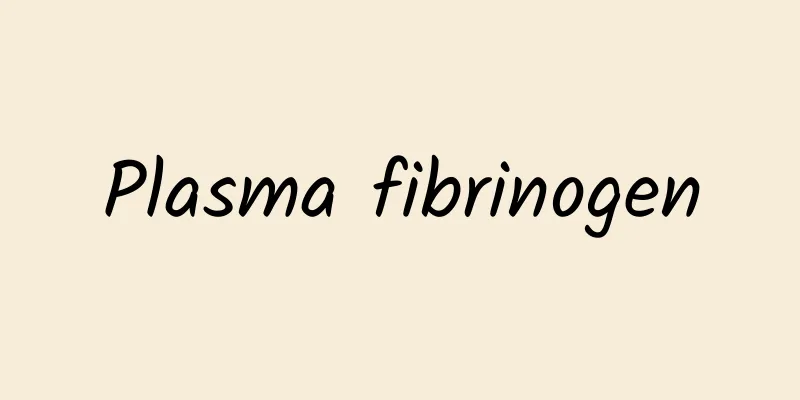Plasma fibrinogen

|
Many friends found that their plasma fibrinogen was not within the normal range during physical examinations, and was either too high or too low, but they did not know what caused it, nor did they know what exactly was going on with plasma fibrinogen. If this is the case, it will be very detrimental to your understanding of your physical condition. Therefore, here we first need to understand what plasma fibrinogen is. Simply put, plasma fibrinogen is a protein with coagulation function. It exists in human blood. Under normal circumstances, it will not play any role, but if it is injured and bleeding, it will show its specific role. The specific functions of plasma fibrinogen in the human body are as follows: Fibrin is a monomeric protein produced during the coagulation process when thrombin cleaves fibrinopeptides A and B from fibrinogen. Simply put, it is a protein related to blood coagulation, namely, coagulation factor. Plasma fibrinogen - plasma fibrin Human plasma contains about 0.2-0.3g/dl. It is a globulin. It contains 3% carbohydrates and is present in 4 segments when Tiselius electrophoresis, filter paper electrophoresis, and cellulose acetate membrane electrophoresis are performed on plasma. It can be precipitated using 25-50% saturated ammonium sulfate, half-saturated sodium chloride and 1.1-1.2M phosphate. Contained in Cohn's first segment. The isoelectric point of human fibrin is pH 5.2-5.6, and the isoelectric point of bovine fibrin is pH 5.5. The molecular weight is said to be 320,000-340,000. The half-life of human fibrinogen in the body is 4-5 days. It is mainly produced in liver cells. The fibrinogen molecule is composed of three polypeptide chains called α (A) chain, β (B) chain, and γ chain, each of which is paired and combined into a dimer by SS bonds. One molecule of fibrinogen is represented by [α (A) β (B) γ) 2. When the blood coagulates, it is acted upon by thrombin. Fibrinopeptide A and fibrinopeptide B are released from the α and β chains of one molecule of fibrinogen to form fibrin monomers. This results in a 3% nitrogen loss. The release of fibrinopeptide A is paralleled by the formation of a fibrin clot (blood cake). However, the release of fibrinopeptide B is slower than that of A. Both peptides are released from the N-terminus of the fibrinogen molecule. It is also known that the amino acid arrangement of fibrinogen is also abnormal or defective, which is called abnormal fibrinogen. Since it cannot exhibit the above mechanism, it often becomes a bleeding factor, so it is called abnormal fibrinogenemia. Plasma fibrinogen - Fg, FIB Plasma fibrinogen Fibrinogen is the precursor of fibrin. In the final stage of coagulation, soluble fibrinogen is converted into insoluble fibrin, causing blood to coagulate. Determination of plasma fibrinogen helps to understand the state of coagulation function. To sum up, you should know what plasma fibrinogen is and what specific functions it plays for the human body. If the plasma fibrinogen level is too high, it is usually related to some cardiovascular and cerebrovascular diseases. If the plasma fibrinogen level is too low, it may be caused by liver disease. |
<<: High ferritin and normal liver function
Recommend
What causes diffuse liver damage?
The causes of diffuse liver damage require specia...
Lumbar disc herniation causing nausea and vomiting
Lumbar disc herniation will not cause nausea and ...
The most effective treatment for vitiligo
Vitiligo is a skin disease that is difficult to t...
Side effects of kudidi
Many people are not particularly familiar with bi...
How to vaccinate neonates against tetanus
Newborn babies are very prone to accidents becaus...
Traditional Chinese medicine teaches you how to understand the condition by looking at the complexion!
Chinese medicine emphasizes observation, ausculta...
What to do if your face is allergic and hot
Some friends may have allergies on their facial s...
How to treat vulvar follicle inflammation
The pathogenic bacteria of vulvar folliculitis ar...
What should I do if I have a lump in my throat?
The throat is an important part of the human body...
Is TCM effective in treating diabetes insipidus? Can it be cured?
The main symptoms of diabetes insipidus are polyu...
Treatment of facial neuritis, Chinese medicine treatment is effective
We can relieve the symptoms of facial neuritis th...
The efficacy of boiled eggs with walnut branches
Boiling eggs with walnut branches has certain hea...
How to cure headache
Headache is a common symptom. There are many caus...
Snake Gallbladder Stewed with Fritillaria
Snake gall and Fritillaria cirrhosa are things th...
Coccyx pain is more common in women, what is the reason
Coccyx pain refers to a strong tingling sensation...









